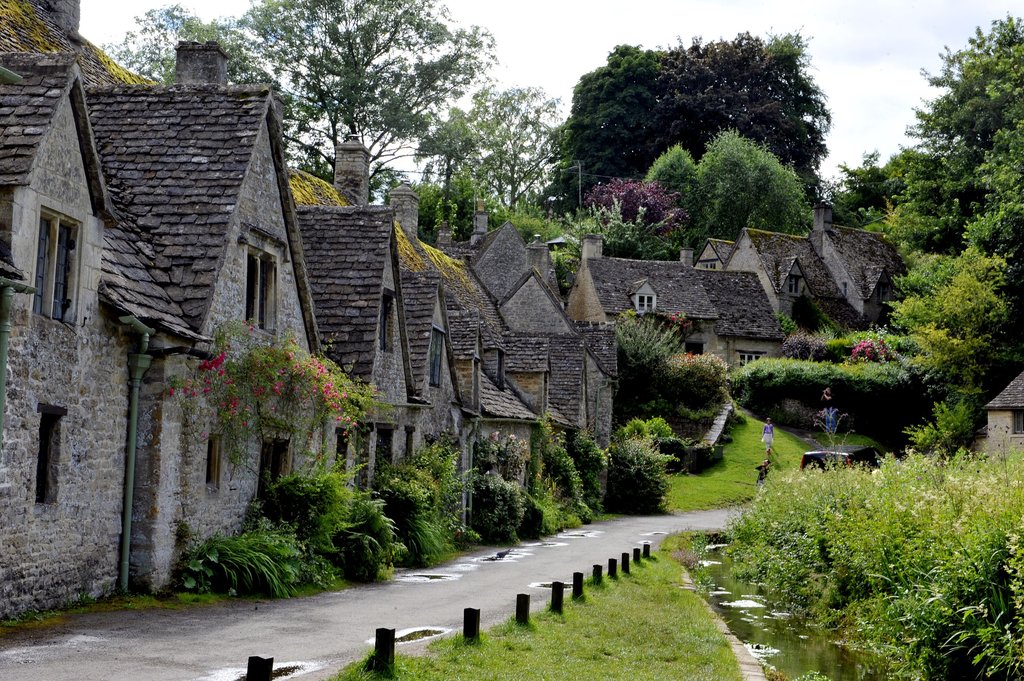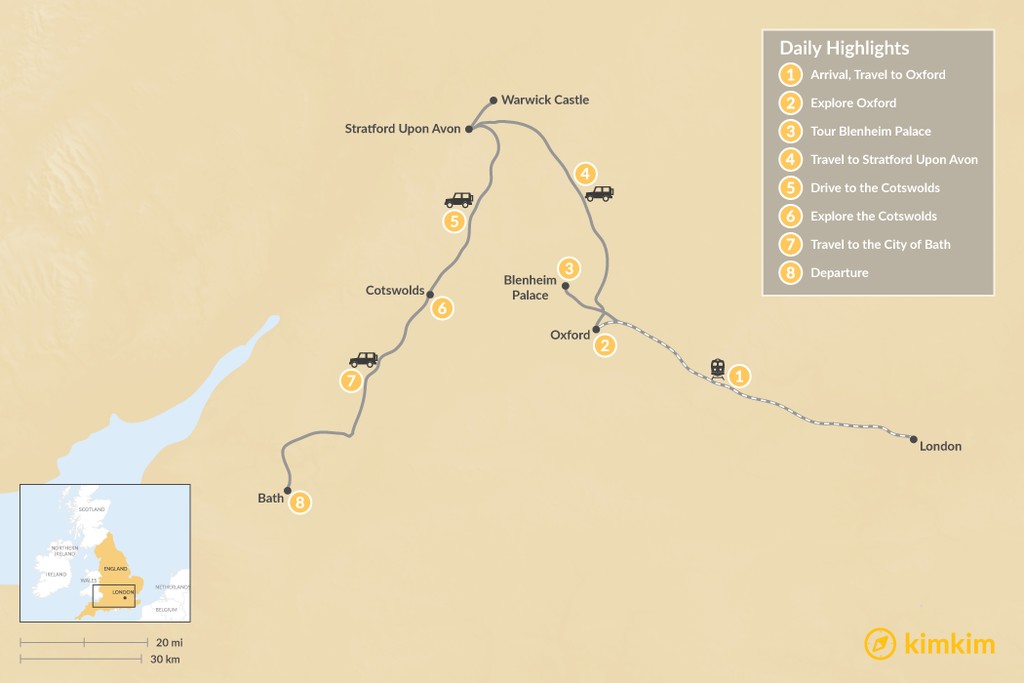
Cotswolds Road Trip - 8 Days

Highlights
- Tour scholarly Oxford, like Bodleian Library and the Christ Church chapel.
- Stroll the storybook lanes of Cotswolds' villages
- Learn about the life of English leader William Churchill at his birthplace
- Walk in the footsteps of William Shakespeare in Stratford-Upon-Avon.
- Visit the Roman baths at Bath, then take in the city's Georgian-era buildings.
Brief Itinerary
| Day | Highlights | Overnight |
|---|---|---|
| Day 1 | Arrival Oxford | Oxford |
| Day 2 | Oxford | Oxford |
| Day 3 | Blenheim Palace & Oxfordshire | Stratford Upon Avon |
| Day 4 | Stratford Upon Avon & Warwick Castle | Stratford Upon Avon |
| Day 5 | Explore the Cotswolds | Bourton on the water |
| Day 6 | Explore the Cotswolds | Bourton on the water |
| Day 7 | Cotswolds and City of Bath | Bath |
| Day 8 | Bath | Bath |
Detailed Itinerary
Day 1: Arrival Oxford

Travel by train from London to the beautiful city of Oxford. After checking into your hotel, set off on foot to explore the historic city center, which, thanks to its famous spires and magnificent buildings is like an open-air museum. Oxford is perhaps best known for its world-renowned university, which is actually composed of many different colleges. Spend your time visiting the multitude of colleges and exploring the city's other treasures. See Day 2 for some ideas.
Day 2: Oxford

On your second day in Oxford, there are a number of different tours and experiences to help you learn more about the city. Make your day as full or open-ended as you like. Here are some great ways to spend your time in Oxford:
- Take a behind-the-scenes tour of Oxford's famous university, led by experienced guides who will show you the best of the colleges and quads, as well as a few hidden corners.
- Take a guided tour of the Bodleian Library. Visit one of the oldest working libraries in the world, known for its awe-inspiring architecture, and hear the stories from the historic heart of the University.
- Take a cruise down the Thames and see Oxford's greener side—a landscape that inspired "Alice in Wonderland."
- For Harry Potter fans, small groups can explore the parts of Oxford University that served as stand-ins for Hogwarts.
- Tour the city on an open-air bus, or do as its students do, and see it on two wheels.
In the evening, enjoy a pint or two and a hearty meal at one of Oxford's many great traditional pubs, some of them the former haunts of famous writers and musicians.
Day 3: Blenheim Palace & Oxfordshire

After wrapping up your brainy tour of Oxford, head north into the beautiful Oxfordshire countryside. Your first stop is Blenheim Palace, one of England's grandest houses and the birthplace of Winston Churchill. His life is well-documented here, but in addition to the historic house, you can also explore the gardens and 2,000 acres of parkland at this UNESCO World Heritage Site.
Afterward, explore pretty, unspoiled villages such as Broughton, Wroxton, and the historic market town of Banbury. Then continue north to reach the lovely town of Stratford-Upon-Avon, the home of William Shakespeare.
Chat with a local specialist who can help organize your trip.
Day 4: Stratford Upon Avon & Warwick Castle

It's hard to imagine a better place to see one of Shakespeare's famous plays than in the city of his birth, Stratford-Upon-Avon. There are several renowned theatres in this pretty market town, and The Bard's works are staged year-round. You can also visit the house where Shakespeare was born as well as the church where he is laid to rest. The river and canal make great places for quintessentially English country walks. A few miles away is Warwick Castle, first built by William the Conqueror in 1068. Experience more than one thousand years of history at this imposing medieval castle, with its Great Hall, dungeon, gardens, historical reenactments, and near-daily events.
Day 5: Explore the Cotswolds

Meander through the beautiful Cotswold Hills, visiting a host of stunning stone-built villages along the way. Among the must-see villages are Bourton-on-the-Hill, Burford, Bourton-on-the-Water, Bibury, Castle Combe & Lacock. We will provide you with an itinerary that outlines the most scenic routes through this Area of Outstanding Natural Beauty.
Two or three days are required to see the best of this fairytale-beautiful area. You'll stay in great small hotels in the heart of the villages.
Day 6: Explore the Cotswolds

After a hearty English breakfast, continue your exploration of the beautiful Cotswold Hills and their unique and well-preserved villages. In-between the more famous villages, you’ll also have the opportunity to explore other quaint settlements, away from the-beaten-tourist-trail. Slow down and enjoy the quintessentially English countryside where babbling streams wind through sublime flower-filled meadows with ancient church towers and rolling hills providing the backdrop.
Among the hamlets and villages you can explore, but which you’ll not see in your usual tourist guide are Ebrington, where the locals still call the village 'Yubberton', Bladon, the resting place of Sir Winston Churchill, Great Tew, where you can get a welcome drink in the Falkland Arms and visit the 3500-year-old Rollright stone circle, and the beautiful stone and thatch village of Minster Lovell.
Day 7: Cotswolds and City of Bath

Continue your journey south through the Cotswolds, taking in stunning panoramas and quaint villages until you reach the beautiful city of Bath. This compact city is built on the side of a hill and straddles the idyllic River Avon, where canal boats ply the slow-moving waters. Bath is known for its well-preserved Roman bath complex, which can be visited. Bath also has countless examples of outstanding 18th-century Georgian architecture, including The Circus, a circular street of refined townhouses. The magnificent interiors and exteriors of Gothic Bath Abbey also merit a visit.
Day 8: Bath

Explore the city of Bath, wandering through its wonderful mix of narrow medieval alleyways and larger Georgian streets. Must-see places include Pulteney Bridge over the River Avon, which houses narrow shops and cafés overlooking the river, the magnificent Georgian architecture of the Circus (circular open space created by the buildings) and the extravagant Royal Crescent. An architecture tour is a great way to get the most out of your visit.
In addition to the sights already mentioned in yesterday's and today's itinerary, Bath is also home to numerous museums, galleries, and points of interest. The city's lively gastropubs make for a fun dinner and night on the town.
